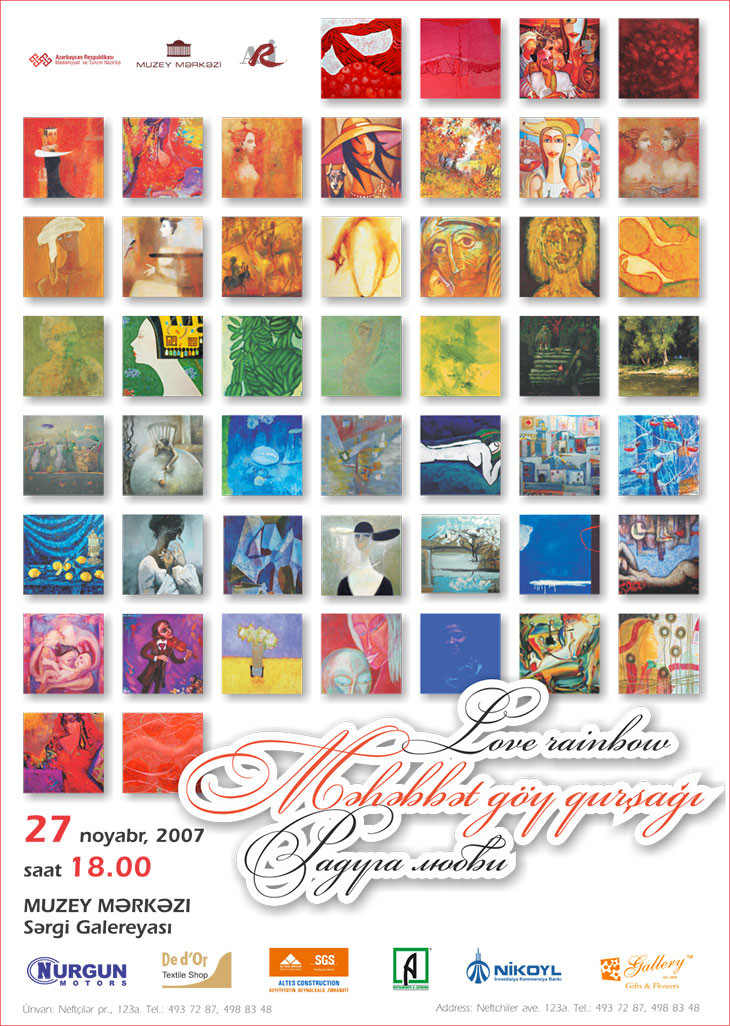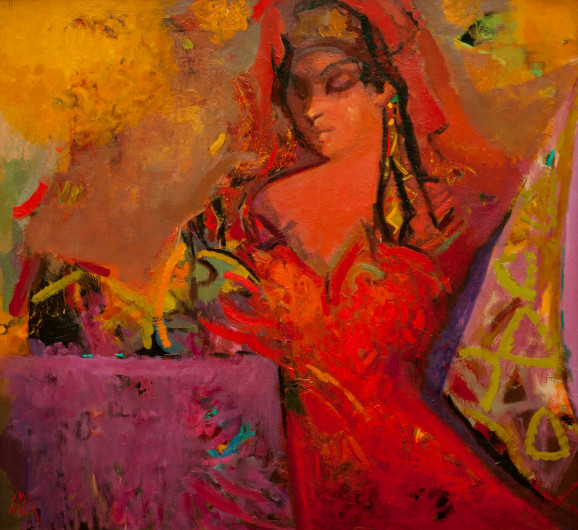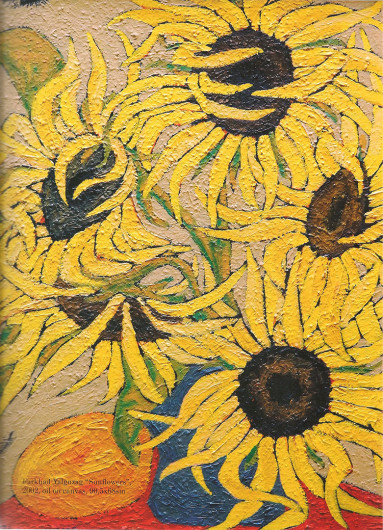
December 2007
THE RAINBOW OF LOVE
Text by Nadejda Ismailova
THE RED CARAVAN, THE GREEN SHADOW, THE PREGNANT VASE, THE REFLECTIONS IN BLUE... THE MUSEUM CENTRE’S ART GALLERY EXPOSES 128 WORKS BY 44 MODERN AZERBAIJANI ARTISTS. A VERY BEAUTIFUL EXHIBITION.
Love and Art have got something in common, indeed. Both are our time compass. Their chief value lies in their capability to reflect the past and the present, and Io foretell the future to an extent. The picturesque poems, the graphic essays and the finely sculptured compositions can tell more of a nation’s mentality can thousands of verbal evidences ever would. The Rainbow of Love exposition is dedicated to love - just what its name says. 'There is no power mightier in the Universe than Love.’ Liana Vezirova, the Museum Centre Director, explains the concept of the event, 'We came to this world to love and to be loved. Everything that surrounds us consists of love and so do we. The new age is that of love and peace; the scales are tipped to-wards these high vibrations. The energy of love will elevate the Humankind to a new tier. This is the 21st century challenge to the civilization and this is also the criterion we have gone by when we, the organizers, chose the pieces. We compiled a peculiar encyclopedia of love in the end.'
Indeed, the exposition is impressing. The forty-four modern artists have produced their paintings, sculptures, graphical pieces, batiks and photographs. Each piece has its love story, its light, colour, sadness, charm - and secret. They are not only about the classic love between a man and a woman: actually, this is the subject that the exposition is lacking in a little bit; rather, the pieces tell of the love for children, people, nature and generally everything that lives and is found on this planet. The graphical series by Teymur Rustamov called The Seven Colours of the Rainbow is perhaps the most original and, at the same time, the most thematic piece to this exhibition. The seven portraits in red, orange, yellow, green, light-blue, navy-blue and violet show the talent of the artist in his avowal of love for the Woman in general and his wife Aytan in particular.
The Dreams by Namig Ismayilzade has the whole colour spectrum in it, too. The young artist gives us a sign telling, “Do away with the pale, ordinary and functional images, and long live the feast of exotic iridescent dreams!'
The colour combination is not an easy art hut the Azerbaijani artists how to deal with it; what is more, they experiment. The author has to admit that the exhibits, the scenography and the general air of love about this show gladdened her heart very much. Like love, every hall of the gallery has its colour theme. The first one is red and conveys the colour preference of the participants of the exposition.

THE RED has always been proud in the Azerbaijani painting, beginning with the paintings by Mikayil Abdullayev, Togrul Narimanbekov and Mir- Javad Javadov.
This is the colour of passion and power, blood and ripe pomegranates, wine and the Communist verse. This exposition is true to the tradition: the vermeil, crimson, scarlet, purple, ruby and red-gold colours are in the fantasies of many artists including Sabina Shikhlinskaya’s Red depicting her favourite pomegranates and Emin Askerov’s Harvest, about pomegranates, again, sort of putting one in mind that this fruit might be an element in the DNA of the Azerbaijani painters. The Latitude of Susceptibility by Mir-Nadir Zeynalov makes the red colour burn in the flames of experimentalism. As for the Other Side of Imagination by Elshan Sarkhanoglu, it is simply impossible to look away from it. The red colour manifested its exceptionality in the works of Niyaz Najafov at the previous 5+ Exhibition - and stood apart, and kind of kept its own counsel amongst the other colours in such pieces as People, The Trick-Track Players and the Still-Lives in Red. The attitude remained the same in his new pieces at the Rainbow: The Red Table, the Blue Table with Pomegranates and The Roses in the White Vase with Pomegranates. Yes, there must be something about their DNA...
The beauty of spirit and love is communicated through red in the works by Rashid Ismayil, perhaps, the most promising participant of the exhibition. The dense energetic environment in the FLAME COLOURED variations is captivating in his Red Love, The Caravan, Remembering Moschino, The Girl in the Paradise and The Woman with the Emerald.
The images of the woman of the sultry Absheron come in the paintings of Eldar Babazade to dance in the tender coral, golden sand and - again - the pomegranates in bloom. The painter puts his beauties in The Girl Wearing a Hat, The Absheron Motif and The Players in the historical context as though trying to accentuate the eternal beauty of the Oriental Woman in this manner.
THE YELLOW is the first of the light colours, according to Goethe and his Treaties on Colour. Once in the yellow hall, do not pass by the lingering melody of the Nostalgia by Ismayil Mamedov and the Oriental interpretation of Don Quixote by Nazim Rahmanov. The yellow, the ochroid and the blue are the colours of Absheron. The powerful natural palette and the shining light are in Farhad Yalguzag’s Sunflowers (ahem!).

In the BLUE interior of the gallery are found the resounding Spring Day in Buzovna by Mir-Nadir Zeynalov and the pensive blue-themed Reflection, the Woman in a Veil and Expectation by Farid Mirzoyev.
THE GREEN is about the national tradition and stands tall in the paintings by the maitre Rafael Abbasov as a magic quality. At least, if you look long at his Lake or Ismayilli, you will soon escape melancholy and feel much better.
The splendid works by Vugar Muradov (The Green Planet, The Green Shadow) are equally green, though the young artist has - and shows - such an acute feeling of the colour harmony that it is indeed rather difficult to pinpoint his colour preferences.
Vugar Muradov, who has turned forty recently, reaffirms his reputation for a first-class colourist, even if we only look at his Naked Flowers and The Blue Still-Life.
The exposition is rich in fruit: The Sunflowers, Persimmons on Snow, Lemons and Apples. The botanists of the painting came up with something that lies between a flowerbed and the vegetable stalls at the bazaar. The most prominent adept of this trend is Nahira Rustamova, the Amazon of the Azerbaijani avant-garde. She had asked herself whether it was true that the artist's world might come as an inspiration from the world of plants. And the answer came in a series of luxurious paintings scattered in almost all the halls of the gallery - THE VIOLET, THE RED, THE ORANGE and THE GREEN. Her paintings depict berries, fruit and vegetables but they fire up one’s sensuality rather than appetite. The Aubergine Madonna, the Tomato Girl, and the Cu-cumber Love - these paintings have irony, grace and charm in them. The main conclusion drawn here is, the new edition of Art Nouveau comes from the living nature around us.
...To revert to the language of the flowers and to translate images into words, one can say that the bouquet of feelings and emotions includes love and anger, meeting and parting, music and silence, narcissism and fidelity, harmony, nostalgia and the eternal mystery of sentiments and colours.
Everything that the true painting is about, in a word. And so is love, after all.